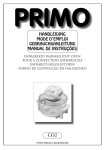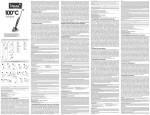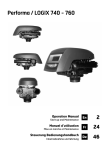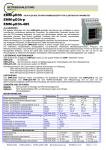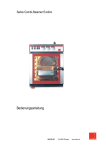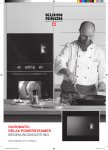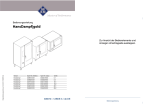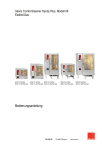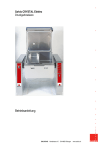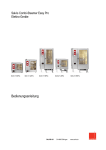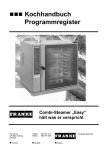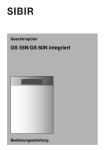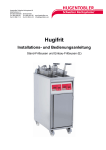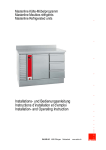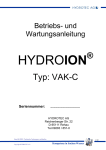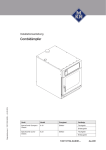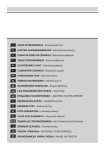Download Installation et mode d'emploi
Transcript
Salvis Steamer SDS 1/1 P „Vitality“ 12 kW 15 kW Installations- und Bedienungsanleitung Instructions d’installation et mode d’emploi Installation- and Operating Instruction SALVIS AG 4665 Oftringen Switzerland www.salvis.ch INHALTSVERZEICHNIS 1. Vorwort ................................................ 4 2. Sicherheit ............................................ 4 2.1 2.2 Hinweiserklärung ...................................... 4 Sicherheitshinweise .................................. 4 3. Allgemeines ........................................ 5 3.1 3.2 3.3 3.4 Bestimmungsgemässe Verwendung ........ 5 Kennzeichnung des Produktes ................. 5 Konformität ............................................... 5 Gefahrenbereich ....................................... 5 4. Installation ........................................... 6 4.1 4.2 4.3 4.4 4.5 4.6 4.10 Technische Daten ..................................... 6 Umgebungsbedingungen ......................... 6 Aufstellung/Platzbedarf ............................. 6 Abluft ........................................................ 6 Elektroanschluss ...................................... 6 Anschluss-/Leistungsbegrenzungssystem (Option) .................................................... 6 Wasserablauf ........................................... 6 Wasseranschluss ..................................... 7 Zubehör zu Wasserablauf (Option) ........... 7 Zubehör zu Wasserzulauf (Option) ........... 7 Installations-Skizze ................................... 8 Anschlüsse/Detailmasse mit und ohne Enthärter ............................. 8 Wasserenthärter ....................................... 9 5. Bedienungs-/Anzeigeelemente ......... 10 5.1 4.7 4.8 4.8.1 4.8.2 4.9 4.9.1 6.4 6.5 6.6 6.7 6.8 6.9 6.10 6.11 6.12 6.13 6.14 6.15 6.16 6.17 6.18 6.19 Betriebsbereitschaft (Standby) erstellen . 11 Manuell Kochen ...................................... 11 Kochen mit Programmen ........................ 11 Kochphasen abfragen / löschen ............. 11 Laden von Originalkochprogrammen ...... 11 Programm abändern .............................. 11 Programm löschen ................................. 12 Neues Programm schreiben / speichern 12 Kerntemperatur-Regelung (Option) ........ 12 Einstellen der Startzeitvorwahl ................ 12 Tageszeit, Datum, Jahr einstellen ........... 12 Regenerieren des Wasserenthärters ...... 12 Ausschalten ............................................ 13 Mögliche externe Anschlüsse ................. 13 Bedienungsfehler-Anzeigen .................... 13 Störungsanzeigen ................................... 13 7. Wartung ............................................ 14 7.1 7.2 7.2.1 7.2.2 7.2.3 7.2.4 Sicherheitshinweise ................................ 14 Reinigung ............................................... 14 Kochkammer .......................................... 14 Verschalung ............................................ 14 Tropfschale ............................................. 14 Türdichtung ............................................ 14 8. Unterhalt ........................................... 14 8.1 Kundendienst ......................................... 14 9. Dokumentation .................................. 14 Bedienungspanel mit Tasten / Anzeigen . 10 10. Gültigkeit ........................................... 14 6. Bedienung ......................................... 11 11. Entsorgung ....................................... 14 6.1 6.2 6.3 Gefahrenhinweise ................................... 11 Anforderungen an das Bedienpersonal .. 11 Beschicken ............................................. 11 12. Erfüllungsort/Gerichtsstand .............. 14 Copyright by SALVIS Switzerland Aarburg, 09/2001, 10/2002 -3- 1. Vorwort - Die Installations- und Betriebsanleitung enthält wichtige Hinweise, um das Gerät sicher, sachgerecht und wirtschaftlich zu betreiben. Ihre Beachtung hilft, Gefahren zu vermeiden, Reparaturkosten und Ausfallzeiten zu vermindern und die Zuverlässigkeit und die Lebensdauer des Gerätes zu erhöhen. - Die Betriebsanleitung wendet sich an alle Personen, welche mit dem Gerät arbeiten. Sie ist von jeder Person zu lesen und anzuwenden, damit die Bedienung, Pflege und Störungsbehebung richtig gewährleistet ist. - Die Betriebsanleitung muss ständig am Einsatzort verfügbar sein. - Die Installationsanleitung wendet sich an alle ausgebildeten Fachleute, welche dieses Gerät installieren und in Betrieb nehmen. - Installationen und Reparaturen, welche nicht von autorisierten Fachleuten vorgenommen werden, sowie technische Veränderungen am Gerät, die nicht vom Hersteller schriftlich genehmigt sind und das Verwenden von nicht Originalersatzteilen, führt zum Erlöschen der Garantie und Produktehaftung durch den Hersteller. 2. Sicherheit 2.2 Sicherheitshinweise Personenschutz 2.1 Hinweiserklärung In den Hinweiskästchen finden Sie drei verschiedene Symbole, die unbedingt beachtet werden müssen. Die Symbole haben folgende Bedeutung: - Das Gerät ist bei sämtlichen Montage-, Instandhaltungs- und Reparaturarbeiten auszuschalten und gegen unbefugtes Einschalten zu sichern (Netztrennung). Dieses Symbol ist ein Sicherheitshinweis, welches Sie bei allen Arbeitsschritten finden, bei denen Gefahr für Personen besteht. Beachten Sie diese Warnungen und verhalten Sie sich in diesen Fällen besonders vorsichtig. Geben Sie diese Warnungen auch an andere Benützer weiter. Geräteschutz Dieses Symbol finden Sie bei allen Arbeitsschritten, die besonders zu beachten sind, damit Beschädigungen an den Geräten verhindert werden können. Geben Sie auch diese Sicherheitshinweise an alle Gerätebenutzer weiter. - Um ungewollten Schäden am Gerät vorzubeugen, ist das Lesen der Betriebsanleitung erforderlich. Ebenfalls müssen die Bediener vom Eigentümer instruiert werden. Generelle Sicherheitshinweise Dieses Symbol gibt Ihnen nützliche Tips und macht auf richtiges Vorgehen und Verhalten aufmerksam. Beachten Sie auch diese Hinweise. Sie können sich damit Zeit und Probleme ersparen. - Lesen Sie diese Betriebsanleitung zuerst sorgfältig durch, bevor Sie das erste Mal mit diesem Gerät arbeiten. Die Salvis AG lehnt jede Haftung ab, wenn die Benutzer die Hinweise missachten, welche auf den Geräten markiert sind und/oder in der Betriebsanleitung stehen. - Wenn anzunehmen ist, dass ein gefahrloser Betrieb nicht mehr gewährleistet ist, muss das Gerät ausser Betrieb gesetzt werden und gegen unbeabsichtigtes Einschalten abgesichert werden (Netztrennung). - Die Reparaturen dürfen nur von autorisiertem Fachpersonal und mit Originalersatzteilen ausgeführt werden. - Das Gerät darf nur von ausgebildeten und oder instruierten Personen bedient werden, welche auch mit den Sicherheitsvorkehrungen des Gerätes vertraut sind. - Beachten Sie neben den Hinweisen in dieser Anleitung auch die allgemein gültigen Sicherheitsund Unfallverhütungsvorschriften. - Die Betriebs- und Installationsanleitung muss immer am Arbeitsplatz verfügbar sein. -4- 3. Allgemeines 3.1 Bestimmungsgemässe Verwendung Der Steamer darf nur für den vorgesehenen Zweck, das heisst für das Kochen, Dämpfen, Aufbereiten, Warmhalten und Erwärmen von Lebensmitteln verwendet werden. 3.2 Kennzeichnung des Produktes Sie finden diese Angaben auf dem Typenschild mit Seriennummer, Jahrgang und - Kennzeichnung an der Seitenwand rechts vorne (von vorne her gesehen und oder auf der Geräteinnenseite links vorne am Innenblech). 3.3 Konformität EN 60335-1 + EN 60335-2-42 sind europäische Normen, welche auch in der Schweiz den Status als anerkannte Regel der Technik haben. Strahlwassergeschützt nach IPX5. -Konform. Dieses Produkt ist 3.4 Gefahrenbereich - Heisser Dampf tritt aus beim Öffnen der Kochkammertüre. Verbrühungsgefahr. - Heisse Oberflächen im Bereich der Kochkammer und der Türe. Verbrennungsgefahr. - Der Deckel des Wasserenthärters darf während dem Betrieb des Gerätes nicht geöffnet werden. Zum Auffüllen des Regeneriersalzes beachten Sie bitte die Anweisung in Kapitel 6.14. - Keine Manipulationen am Türverschluss. Gerät steht unter Druck! - Am Drucksteamer dürfen nur ausgebildete Fachleute Reparaturen vornehmen! - Bei ausgeschaltetem Gerät wird das Wasser des Dampferzeugers erst nach ca. 5 Minuten abgelassen. Diese Zeit ist abzuwarten, bevor an Schläuchen usw. des Ablaufes gearbeitet wird. Es besteht sonst akute Verbrennungsgefahr. - Wenn am Gerät repariert wird, muss immer eine allseitige Netztrennung erfolgen. ACHTUNG! Bei einer Netztrennung erfolgt die Boilerentleerung sofort. Es entweicht heisses Wasser (ca. 95°C) aus dem Boiler in den Ablauf. Verbrennungsgefahr! -5- 4. Installation 4.1 Technische Daten Apparate-Typen Leistung Anschlusswert Absicherung Gewicht SDS 1/1 P mit Enthärter 12 kW 400V 3 N AC 5 x 2.50 mm2 20 A 102 kg SDS 1/1 P mit Enthärter 15 kW 400V 3 N AC 5 x 2.50 mm2 25 A 102 kg SDS 1/1 P ohne Enthärter 15 kW 400V 3 N AC 5 x 2.50 mm2 25 A 97 kg SDS 1/1 P mit Enthärter 15 kW 230V 3 40 A 102 kg 4.6 Anschluss-/Leistungsbegrenzungssystem (Option) 4.2 Umgebungsbedingungen Temperatur: Feuchtigkeit: AC 4 x 6.00 mm2 7°C - 40°C 90% relative Luftfeuchtigkeit, nicht kondensierend. - Dem Gerät ist ein Anschlussschema mit Anschlussbeschrieb beigelegt. Es befindet sich auf der linken Seite im Elektrofach. 4.3 Aufstellung/Platzbedarf 4.7 Wasserablauf - Auf Original-Salvis Untergestell oder waagrechter und stabiler Arbeitsplatte. - Gerät waagrecht einjustieren. - Geringe Unebenheiten können mit den verstellbaren Füssen ausgeglichen werden. Nachdem der Steamer an der richtigen Stelle platziert ist, soll er mit den 4 Stück Gleitschutz (in der Kochkammer beiliegend) gegen ein Verschieben gesichert werden. - Mindestabstände: links und rechts 50 mm, hinten mind. 20 mm - Doppelstockausführung wird nicht empfohlen! Ablauf mit offener Trennstrecke D am pfkondensator S chlauch Geberit-Rohr G 3/4" 2 cm offene Trennstrecke 4.4 Abluft - Eine Dunstabzugshaube ist nicht zwingend notwendig. Jedoch sind die speziellen küchentechnischen und örtlichen Vorschriften zu beachten. - Wärmemenge: latent 3500 kJ/h fühlbar 5000 kJ/h 4.5 Elektroanschluss - Vor Geräteanschluss, Angaben auf Typenschild beachten an der Seitenwand rechts vorne (von vorne her gesehen und oder auf der Geräteinnenseite links vorne am Innenblech). Landesspezifische und örtliche Vorschriften beachten. - DIE GERÄTE DÜRFEN NUR DURCH AUTORISIERTE ELEKTRO-INSTALLATEURE ANGESCHLOSSEN WERDEN. Es müssen die örtlichen Vorschriften eingehalten werden. - Elektroschema im Gerät. - Das Gerät wird mit ca. 1.5 m Kabel ohne Stecker ausgeliefert. - Bauseits vorsehen: Allpolige Trennvorrichtung mit mind. 3 mm Kontaktabstand. - Anschlusswerte/Absicherung siehe 4.1 - Eigene abgesicherte Zuleitung für jedes Gerät. - Gerät an Potential-Ausgleich anschliessen. Die Schraube befindet sich auf der linken Seite unter dem Gerät und ist mit folgendem Symbol gekennzeichnet: - Steckdose nahe am Gerät plazieren. - Mit dampftemperaturbeständigem Schlauch, Artikelnummer: BI 278583 - Rohr und Schlauch mit stetigem Gefälle. - Ablauf offen in Trichter. - Trichter nicht unter dem Gerät plazieren. - Abstand Auslauf zum Trichter 2 cm. Fester Ablaufanschluss mit Entlüftungstrichter m in. 5 cm Schlauch G 3/4" - Schlauch mit stetigem Gefälle montieren - Zwischen Unterkante Steamer + Oberkante Trichter muss ein Abstand von mindestens 5 cm sein. - Gerät ohne Ablaufentlüftung nicht direkt an Siphon anschliessen. -6- 4.8 Wasseranschluss 4.8.1 Zubehör zu Wasserablauf (Option) - Nur an kaltes Wasser in Trinkwasserqualität anschliessen. - Bauseits: Wasserabsperrhahn und Filter (50 Mikron) Druckreduzierventil und Rückschlagventil montieren. 1 Wasserdruck - Netzdruck reduziert auf 3.5 bar; - Fliessdruck min. 2.2 bar - Fliessdruck mit Netzdruck nicht erreichbar, Druckerhöhung mit vorgeschalteter Pumpe! - Unbedingt verhindern, dass der Anschlussdruck durch zusätzliche Verbraucher unter 2.2 bar fallen kann!! Anschluss für Geräte mit integriertem Enthärter m in. 5 cm 1 2 1 Schlauch komplett BI 278583 Hartwasseranschluss 1 Schlauch komplett BI 278583 2 Entlüftungstrichter kompl. BI 172448 4.8.2 Zubehör zu Wasserzulauf (Option) Für Geräte mit integriertem Enthärter Hartwasseranschluss G 3/4" G 3/4" G 1/2" G 3/4" Anschluss für Geräte ohne integrierten Enthärter G 3/4" G 1/2" Weichwasseranschluss Anschlussgruppe komplett BI 172449 bestehend aus: 1 Rückschlagventil 1 Druckreduzierventil 1 Absperrhahn Hartwasseranschluss G 3/4" Für Geräte ohne integrierten Enthärter Weichwasseranschluss Hartwasseranschluss G 3/4" G 3/4" G 1/2" Anschluss Weichwasser (Dampfaufbereitung): - Wasser auf 0° Carbonathärtegrade enthärten durch Gegenosmose-Anlage oder selbstregenerierende Hauswasserenthärtungsanlage (Ionentauscher) Anschluss Hartwasser (Dampfablöschung) an nicht aufbereitetes Netzwasser: - Kann auch an Weichwasser angeschlossen werden, dann Anschluss über dieselbe Armaturengruppe mittels Tee-Stück. Wasserverbrauch total: - Ca. 30 l/h (Hart- und Weichwasser) G 3/4" G 1/2" Anschlussgruppe komplett 2 x BI 172449 bestehend aus: 2 Rückschlagventil 2 Druckreduzierventil 2 Absperrhahn -7- 4.9 Installations-Skizze min. Seitenabstand 848 50 727 50 624 20 242 382 362 680 min. Wandabstand 262 550 130 50 74 19 4.9.1 Anschlüsse/Detailmasse mit und ohne Enthärter 29.5 107 152 126 83 85 133 70 120 150 278 Ausführung mit Enthärter 3 4 5 6 7 8 Ausführung ohne Enthärter 9 10 3 4 5 7 8 9 10 1 2 1 11 11 Legende: 1 2 3 4 5 6 Hartwasseranschluss 3/4“ Weichwasseranschluss 3/4“ HACCP; Schnittstellenanschluss Meldeleitung LBS 2 und 3 LBS-Anschluss (Leistungsbegrenzung) Enthärter (Salzeinfüllstutzen) 7 8 9 10 11 -8- Elektrischer Anschluss Pg 29 Elektrischer Anschluss Pg 21 Separates Steuerungskabel LBS 3 Sicherheitsventil, Dampferzeuger Kondensatablauf 3/4“ 4.10 Wasserenthärter - Der Wasserenthärter funktioniert gemäss dem Prinzip des Ionenaustauschers. - Der Behälter enthält ca. 3.0 Liter Austauschharz, welches im regenerierten Zustand das im durchfliessenden Wasser enthaltene Calciumcarbonat Ca2O2 aufspaltet, indem das Harz die Ca-Ionen gegen NaIonen austauscht. - Das so entstandene Na CO2 setzt sich nicht ab, sondern wird mit dem Kondensat und Restwasser weggeschwemmt. - Während des Garbetriebes wird das Austauschharz mit Ca-Ionen gesättigt, d.h. es verliert immer mehr die Fähigkeit, das Wasser zu enthärten. - Nach erfolgter Sättigung des Austauschharzes muss dieses mittels ca. 0.5 Kg haushaltüblichem Regeneriersalz wieder regeneriert werden. - Die Regenerier-Abstände sind abhängig von der Wasserhärte. - Die Salzlösung, welche über eine vorgegebene Zeit mit dem Austauschharz in Berührung steht, tauscht die Ca-Ionen wieder gegen Na-Ionen aus. Der Enthärter ist wieder voll aufnahmefähig. - Das Regenerieren des Wasserenthärters wird in Kapitel 6.14 beschrieben. - Wie man den Wasserkredit einstellt, wird in der Beschreibung im Servicehandbuch «Einstellung des Regenerationsintervalls der Wasserenthärter» beschrieben und ist ebenfalls jedem Gerät beigelegt (siehe Dokument unten). Drucksteamer FS 1/1 P „Vitality“ Einstellung des Regenerationsintervalls der Wasserenthärter Es sind drei Enthärtertypen möglich: - Im Gerät eingebaut - Vorgeschaltet Brita, Standard - Vorgeschaltet Brita, Jumbo Aufgrund der vorhandenen Wasserhärte, ist aus untenstehender Kurve der Wasserkredit-Code abzulesen und wie folgt einzugeben: Eingabe im Serviceprogramm: F5 auf P5 Eingabe 1 = Brita Standard Eingabe 2 = Brita Jumbo Eingabe 3 = Integrierter Wasserenthärter F5 auf P6 Eingabe-Code 1-9 je nach Härtegrad des Wassers Code 9 S a lz -B e c h e r Beispiel: Code auslesen für integrierten Enthärter Annahme, Wasserhärte 20°d = Code 5 8 7 6 BR IT A 5 4 Werkseinstellung 3 2 Int erg rie En r te rW th är ass te ere rS nth ta ärt nd er ar d/ Ju m bo 1 deutsche Härtegrade 5 15 10 10 30 20 25 20 35 30 50 40 70 60 englische Härtegrade S a lz 5 10 15 20 25 30 35 40 Wasserhärte Messwerte / Einstellungen Nr. °deutsch 1 2 Art.-Nr. 1W 700 312 01/2001 H a rz -9- °franz. °englisch Code °d 40 °f französische Härtegrade Datum Name 45 °e 50 5. Bedienungs-/Anzeigeelemente 5.1 Bedienungspanel mit Tasten / Anzeigen EIN-/AUS-Taste Programmierwahl-Taste Anzeige Programmnummer Anzeige Kochphasen Aktuelle Phasen Belegte Phasen Anzeige Temperatur Kochphasenwahl-Taste Temperaturwahl-Taste Garraum Anzeige Zeit Zeitwahl-Taste Anzeige Kerntemperatur Kerntemperatur-Wahltaste Summer-Anzeige Summer-Taste Zehnertastaturblock mit Dezimalpunkt Eingabe aller Werte und Funktionen Clear-Taste Löschen Enter-Taste Eingabebestätigung Start-/Stop-Taste Programmspeicher-Taste Tageszeit-Taste Startzeitvorwahl-Taste 24 Stunden Anzeige Tageszeit Startzeit-Vorwahl Bedienungsfehler Funktionsfehler Tageszeit-Anzeige - 10 - 6. Bedienung 6.6 Kochen mit Programmen P drücken. Das zuletzt eingegebene Programm wird angezeigt, z.B. P 6.1 Gefahrenhinweise - Heisser Dampf tritt aus beim Öffnen der Kochkammertüre. Verbrühungsgefahr. - Die Behälter und Normschalenhalterungen sind heiss. Verbrennungsgefahr. drücken, die Diode blinkt abwechslungsweise mit . der Anzeige Gewünschte Programmnummer mit 10er Tastatur eingeben. Bereits existierende Programmplätze siehe Programmregister. drücken. Das Programm wird angezeigt. drücken. Das Gerät startet. 6.2 Anforderungen an das Bedienpersonal - Dieses Gerät darf nur von qualifiziertem und ausgebildetem Personal benutzt werden. - Es empfiehlt sich, an einem SALVIS Anwenderseminar teilzunehmen. - Kochtechnische Angaben finden Sie im Kochhandbuch (Programmsteller). - Die Bedienungsanleitung muss von jeder Person gelesen werden, welche mit dem Gerät arbeitet. - Während des Betriebes können alle Werte verändert werden. Diese müssen mit Taste - Gerät nicht überfüllen (Kochgut nicht über Oberkante der Normschalen einfüllen). - Achtung: Um Korrosionsschäden im Garraum und an den Seitenkonsolen zu verhindern, soll das Kochgut nach dem Garen gesalzen oder gewürzt werden. Salzrückstände führen unweigerlich zu Rostfrass!! -Taste drücken. Zum Quittieren, die Bei Prozessende ertönt der Summer während 20 Sekunden, bis er quittiert wird. Ist der Summer zwischen den Kochphasen programmiert, ertönt er während 4 Sek. intermittierend. Schreiben Sie Ihre eigenen Programme auf beiliegende Hilfsblätter und halten Sie diese unter Verschluss. So können Sie Ihre Programme problemlos wieder programmieren, sollten diese aus Versehen gelöscht werden. Die gerade aktuelle Temperatur im Garraum sowie die - 6.4 Betriebsbereitschaft (Standby) erstellen - drücken, Gerät schaltet ein, und blinken. Der Restwasserkredit des Weichwassers, welches vom Wasserenthärter aufbereitet wird, erscheint in Prozenten . Ist dieser Kredit abgelaufen, wird eine Regeneration notwendig (siehe Kapitel 6.15). Nach ca. 2.5 Minuten ist der Dampferzeuger aufgeheizt. Das Gerät ist betriebsbereit. Dies wird angezeigt durch Blinken der Dioden P und . oder bestätigt werden. Die neuen Werte haben nur für den gerade ablaufenden Koch-/Garprozess Gültigkeit. - Bei Phasenende ertönt der Summer intermittierend, wenn programmiert. 6.3 Beschicken Anzeigen P . gewählte Zeit können mit der Taste . jederzeit abgefragt werden. - Der Kochtemperaturbereich im Garraum liegt zwischen 50° - 119°C. Werden tiefere oder höhere Werte eingeben, so werden diese vom Programm nicht akzeptiert. Zu tiefe Temperaturen springen automatisch auf 50°C und zu hohe auf 119°C. 6.7 Kochphasen abfragen / löschen 1 -3 C Anzeige der Phase 2 von 3 Phasen drücken, Phase 2 wird gelöscht 6.5 Manuell Kochen Neue Anzeige. Die nachfolgenden Phasen rutschen automatisch nach. drücken. Die zuletzt eingegebenen Werte werden angezeigt. 6.8 Laden von Originalkochprogrammen erneut drücken, Diode blinkt rot. Im Anzeigenfeld . erscheint Neuen Wert über 10er Tastatur eingeben; Nach Programmnummer-Eingabe, Tasten und P drücken. In der Programmnummernanzeige erscheint ein Punkt. Das Programm kann beliebig verändert werden. Das Originalprogramm ist noch vorhanden. drücken, Diode blinkt rot. Im Anzeigenfeld erscheint . Neuen Wert über 10er Tastatur eingeben; drücken, um die Eingabe zu bestätigen. drücken, Gerät startet. 6.9 Programm abändern P abrufen. Gewünschte Werte ändern. Mit Tastenfolge M - 11 - neue Werte speichern. 6.10 Programm löschen P letzte Eingabe erscheint zu löschendes Programm drücken, Diode blinkt P drücken und Programmnummer eingeben. Mit folgender Tastenkombination Programm löschen. C M Anzeige mit 10er Tastatur Zeit eingeben Programmnummer drücken zum Speichern 6.11 Neues Programm schreiben / speichern drücken, Anzeigen verlöschen. drücken, Gerät schaltet ein. P + Gerät startet selbständig. Dioden blinken. Wenn das Kochprogramm beendet ist, ertönt der Summer. P drücken, die zuletzt eingegebene Programmnummer wird angezeigt. - Durch Drücken der Taste werden die Anzeigen beleuchtet und die Uhrzeit wird angezeigt. blinken. P drücken, Eingabe einer freien Programmnummer (siehe Programmregister), z.B. Eine leere Programmnummer kann auch durch Drücken von M und 0 ausgelesen werden. 1. Phase programmieren: drücken, 1 -3 und P oder Dioden 2. und 3. Phase programmieren: blinken. Tageszeiteingabe: erscheint. drücken Stunden und Minuten eingeben. 2x drücken, erscheint. Analog 1. Phase programmieren. Speichern der Daten. 1 -3 drücken, P Entweder drücken zum Bestätigen. M . Zum Einstellen muss das Gerät in eingeschaltetem Zustand sein. drücken, Wert eingeben, z.B. 2x drücken, Drücken der Taste . 6.14 Tageszeit, Datum, Jahr einstellen erscheint. drücken, Wert eingeben, z.B. 1 -3 und drücken, um in den Startzeit- Tasten vorwahl-Modus zurückzukehren. - Ist-Zeit und Programmnummer abfragen durch Mit der . -Taste Stunden und Minuten trennen. drücken zum Bestätigen blinken. Eingabe des Datums: Programmnummer eingeben , dann drücken zum Speichern drücken Tag und Monat eingeben. 6.12 Kerntemperatur-Regelung (Option) - Kerntemperatur-Fühlerspitze in die Mitte des Gargutes stecken. Türe schliessen. P Mit der . drücken zum Bestätigen Eingabe des Jahres: Programm wählen oder , dann Garraumtemperatur wählen starten Zeitschaltuhr ist ausser Funktion Nach Erreichen der vorgewählten Temperatur, ertönt der Summer oder der Prozess springt zur nächsten Phase. Ist der Fühler nicht im Gargut eingesteckt, so erhöht sich die Fühlertemperatur zu schnell. Ein Bedienungsfehler 12 wird angezeigt. Summer ertönt, bis Quittierung erfolgt. Soll die Kerntemperatur nach Erreichen erhöht werden, ist eine Temperaturdifferenz von mind. +3°C notwendig. - - 6.13 Einstellen der Startzeitvorwahl P Gewünschtes Kochprogramm eingeben drücken, Diode blinkt drücken Jahr eingeben Kerntemperatur wählen 20 - 100°C - -Taste Tag und Monat trennen. drücken zum Bestätigen drücken, retour auf Tageszeit. Achtung: Nach längerem Netzunterbruch muss die Tageszeit wieder eingestellt werden. 6.15 Regenerieren des Wasserenthärters - Wenn Anzeige leuchtet, können je nach Wasserkredit weitere Garprozesse gestartet werden. leuchtet, muss das Gerät - Wenn Anzeige regeneriert werden. Bei dieser Anzeige wird der Normalbetrieb blockiert. Es kann kein neuer Garprozess gestartet werden. Zudem muss sichergestellt werden, dass der aktuelle Garprozess vor der Regeneration vollständig abgelaufen ist. - 12 - - Starten des Regenerationsprozesses nach der (freiwillig) Anzeige Taste P drücken und Programm wählen. betätigen und Start-/Stop Taste drücken. - Starten des Regenerationsprozesses nach der Anzeige Programm (obligatorisch) wird bereits angezeigt. betätigen und Start-/Stop Taste drücken. Weiteres Vorgehen für beide Varianten: Der Dampferzeuger wird entleert. Warten bis der Summer ertönt. Die Anzeige Deckel vom Wasserenthärter entfernen. Bestätigen mit HACCP-Protokolldrucker Voraussetzung: Muss im Servicebaum angemeldet sein. Die Drucksprache muss angewählt sein. Ist ein HACCP-Protokolldrucker am Gerät angeschlossen, kann das Druckerintervall vom Betreiber wie folgt geändert werden: - Steuerung ausschalten. - erscheint. . Warten bis der Summer ertönt und - Taste gedrückt halten und Steuerung einschalten. Taste drücken. Mittels Ziffertasten IntervallNeueingabe. Taste drücken zum Bestätigen. - Drucker einschalten. Mit dem Start des Garprozesses wird der Ausdruck automatisch gestartet. Es ist möglich, die Zähler und Einstell-Parameter auszudrucken. Im Select-Modus , der Summer verstummt. Während 1 - 3 mal 15 Sekunden wird die Leitfähigkeit des Wassers gemessen. Ein hörbares Fliessen des Wassers durch den Basenaustauscher ist vernehmbar. Wenn die Leitfähigkeit in Ordnung ist, erscheint in der (LED blinken) Tasten . und C drücken. 6.18 Bedienungsfehler-Anzeigen die Regenerationszeit Minuten. Zeitanzeige Der Regenerationsprozess läuft ab. Wurde kein Salz aufgefüllt und nur die Betätigungstaste Diese erscheinen 2-stellig in der Zeitanzeige, gleichzeitig ertönt der Summer. Kerntemperaturfühler ist nicht eingesteckt oder die eingegebene Temperatur ist tiefer als die gemessene Temperatur. In einer Kochphase sind die eingegebenen Werte verloren gegangen. Gerät abschalten und Programm neu abrufen. gedrückt (Leitfähigkeit zu tief), muss die Taste nochmals betätigt werden. . Es erscheint automatisch die Anzeige Der ganze Vorgang muss mit Salz wiederholt werden. drücken zum Summer abstellen. 6.16 Ausschalten drücken. Das Gerät ist ausgeschaltet. 6.19 Störungsanzeigen Nach 5 Minuten entleert sich der Boiler selbständig. Erscheint 2-stellig in der Zeitanzeige. Gleichzeitig ertönt der Summer. Garraumfühler Unterbruch Garraumfühler Kurzschluss Wir empfehlen, das Gerät erst dann auszuschalten, wenn es nicht mehr benötigt wird. Damit verhindert man das Entleeren des Boilers, das Gerät bleibt in Bereitschaftsbetrieb. Sie sparen Energie, gleichzeitig wird der Regenerierzyklus verlängert, weil der Boiler weniger oft gefüllt werden muss. Thermoelement Niveausonde Leerlauf Thermoelement Niveausonde Kurzschluss Timeout Wasserniveau Timeout Druckschalter Sicherheitsdruckschalter Dampferzeuger Problem Heizungsschütz 6.17 Mögliche externe Anschlüsse Salvis Cuisine Control (Küchenleitsystem) Voraussetzung: Schnittstelle RS485 im Gerät aktiviert. Hauptmenus unter anderem: - Geräteüberwachung mit automatischer HACCP-Dokumentation - Energieoptimierung - Kühlhaus-Temperaturüberwachung - Gerätesteuerung vom zentralen Leitstand - Frühwarn- und Alarmsystem - u.s.w. P Es erscheint in der Temperaturanzeige. In der Zeitanzeige erscheint das aktuelle Druckintervall in Minuten. erscheint. in der Anzeige Sicherstellen, dass der Wasserstand im Basenaustauscher knapp unterhalb des Einfüllstutzens ist. Mit dem mitgelieferten Massbecher 0.5 kg Regeneriersalz einfüllen. Deckel des Wasserenthärters wieder schliessen. Bestätigen mit Salvis Data-Manager Voraussetzung: Freigabe Schnittstelle RS232 und Anschluss auf PC über Konverterkabel Eigenschaften: Verwaltung der Combi- und DruckSteamer Programme auf dem PC. Programme neu schreiben, abändern sowie up- und download zu den Geräten. Kerntemperaturfühler Unterbruch (es kann ohne Fühler weitergearbeitet werden). Kerntemperaturfühler Kurzschluss (es kann ohne Fühler weitergearbeitet werden). Leitfähigkeit des Wassers nach Regeneration zu hoch. Regeneration OHNE SALZ wiederholen. Bei Anzeige einer dieser Störungen, Gerät ausschalten. Der Summer stellt ab. Servicestelle benachrichtigen. - 13 - 7. Wartung 8. 7.1 Sicherheitshinweise 8.1 Kundendienst - Bei Störungsfällen am Drucksteamer, kontaktieren Sie bitte Ihren regionalen SALVIS-Vertreter oder wenden Sie sich bitte an den SALVIS-Kundendienst in Aarburg. - Geben Sie bitte bei jeder Meldung an unsere Servicestelle die Apparatenummer sowie den Typ an. Sie finden diese Angaben auf dem Typenschild an der Seitenwand rechts vorne (von vorne her gesehen und oder auf der Geräteinnenseite links vorne am Innenblech). - Wartungsarbeiten dürfen nur vom Fachmann und am vom Netz getrennten und abgekühlten Gerät ausgeführt werden. 7.2 Reinigung 9. - Zum Reinigen des Gerätes keine chlor-, säure- oder metallhaltigen Zusätze sowie keine Scheuermittel oder Stahlscheurschwämme verwenden. - Nur lebensmitteltaugliche Reinigungsmittel verwenden. - Keinen Hochdruckreiniger oder Wasserschlauch verwenden. 7.2.1 Kochkammer - Die Kochkammer wie folgt täglich reinigen: - Die Normschalenhalterungen links und rechts (1) anheben und aus der Kochkammer ziehen. - Kochgutreste aus der Kochkammer entfernen. - Kochkammer und Normschalenhalterungen mit Wasser und einem milden Reinigungsmittel reinigen, spülen und mit einem sauberen, trockenen Lappen austrocknen. - Sieb (2) entfernen und reinigen. - Achtung: Durch ungenügende Reinigung entstandene Salzrückstände führen unweigerlich zu Rostfrass! 7.2.2 Verschalung - Die Verschalungsbleche sind aus rostfreiem Stahl und können mit einem handelsüblichen Chrom-stahlreiniger gereinigt werden. Wir empfehlen Ihnen den Reinigungs-Spray mit der Artikelnummer: BK 176204 7.2.3 Tropfschale - Die Tropfschale (3) nach vorne aushängen, entleeren, reinigen und wieder einhängen. 2 3 Dokumentation - Diese Dokumentation ist gemäss Urheberrecht unser geistiges Eigentum und darf nur zum eigenen Gebrauch kopiert werden. Kopien, auch nur auszugsweise, benötigen die schriftliche Erlaubnis der Firma Salvis AG, Aarburg. 10. Gültigkeit - Ohne anderslautende Mitteilung ist diese Dokumentation in allen Teilen gültig . Es können jedoch ohne vorherige Mitteilung Masse und Aussehen der Produkte ändern. 11. Entsorgung - Die Entsorgung ist Sache des Kunden. Das Gerät kann problemlos der nächsten Altmetallsammlung übergeben werden. Es wurde bei der Produktion kein Material verwendet, welches als Sondermüll entsorgt werden müsste. - Die Elektronikteile müssen speziell entsorgt werden. Wenden Sie sich bitte an eine lokale Recycling-Firma. 12. Erfüllungsort/Gerichtsstand - Erfüllungsort und Gerichtsstand ist Aarburg. Dies gilt auch dann, wenn auswärtige die Montage übernommen haben. Zur Anwendung kommt immer die schweizerische Rechtssprechung. 7.2.4 Türdichtung - Türdichtung (4) entfernen und mit sauberem und säurefreiem Abwaschmittel reinigen. - Dichtungsfläche mit einem feinen «Scotch-Brite» Schwamm reinigen, bevor die Türdichtung wieder an der Türe angebracht wird. 1 Unterhalt 4 - 14 - TABLE DES MATIÈRES 1. Avant-propos .......................................... 16 2. 2.1 2.2 Sécurité .................................................. 16 Légende des remarques ......................... 16 Remarques concernant la sécurité ......... 16 3. 3.1 3.2 3.3 3.4 Généralités ............................................. 17 Utilisation appropriée .............................. 17 Designation distinctif du produit .............. 17 Conformité .............................................. 17 Zones de dangers .................................. 17 6.9 6.10 6.11 4. 4.1 4.2 4.3 4.4 4.5 4.6 Installation .............................................. 18 Données techniques ............................... 18 Conditions environnementales ............... 18 Emplacement / espace utile ................... 18 Aération .................................................. 18 Raccordement électrique ........................ 18 Raccordement du système de limitation de puissance (Option) ............................ 18 Evacuation d’eau .................................... 18 Raccordement d’eau .............................. 19 Accessoires pour évacuation d’eau (Option) .................................................. 19 Accessoires pour alimentation d’eau (Option) .................................................. 19 Esquisse d’installation ............................ 20 Raccordements/mensurations détaillées avec ou sans adoucisseur ...................... 20 Adoucisseur d’eau .................................. 21 6.13 6.14 4.7 4.8 4.8.1 4.8.2 4.9 4.9.1 4.10 5. 5.1 Eléments de commande et d’affichage ... 22 Tableau de commande à touches / Affichage ................................................ 22 6. 6.1. 6.2 6.3 6.4 Utilisation ................................................ 23 Signalement des dangers ....................... 23 Exigences envers le personnel utilisateur 23 Chargement ........................................... 23 Etablir la situation d’attente (Standby) ..... 23 6.5 6.6 6.7 6.15 6.16 6.17 6.18 6.19 Cuisson manuelle ................................... 23 Cuisson avec programme ....................... 23 Interrogation / annulation des phases de cuisson .............................................. 23 Chargement de programmes de cuisson originaux ................................................. 23 Modification de programmes .................. 23 Effacement de programmes ................... 24 Ecrire et mémoriser un nouveau programme ............................................. 24 Réglage de la température à coeur (Option) .................................................. 24 Réglage de la minuterie de démarrage ... 24 Réglage de l’heure, du jour, de la date et de l’année ........................................... 24 Régenération .......................................... 24 Mettre hors service ................................. 25 Branchements externes possibles .......... 25 Affichage d’erreurs de manipulation ....... 25 Affichage d’erreurs de fonctionnement ... 25 7. 7.1 7.2 7.2.1 7.2.2 7.2.3 7.2.4 Maintenance ........................................... 26 Indication de sécurité .............................. 26 Nettoyage ............................................... 26 Chambre de cuisson .............................. 26 Coffrage ................................................. 26 Egouttoir ................................................. 26 Joint de porte .......................................... 26 8. 8.1 Entretien ................................................. 26 Service clientèle ..................................... 26 9. Documentation ....................................... 26 10. Validité .................................................... 26 11. Elimination .............................................. 26 12. Lieu d’exécution / siege .......................... 26 6.8 6.12 - 15 - 1. Avant-propos - Les instructions d’installation et mode d’emploi contiennent d’importants signes et recommandations aidant à l’utilisation correcte et économique de l’appareil. Leur observation permet d’éviter des risques de tous genres, de réduire les coûts des réparations et des durées d’immobilisation ainsi que d’augmenter la fiabilité et la longévité de l’appareil. - Le mode d’emploi est destiné à toutes personnes appelées à travailler avec l’appareil. Il doit être lu et mis en pratique par chaque utilisateur afin que l’emploi, l’entretien et l’élimination des dérangements soient effectués correctement. - Le mode d’emploi doit être constamment à portée de main sur la place de travail - L’instruction d’installation s’adresse à des professionnels formés, aptes à installer l’appareil et à le mettre en service. - Les installations et réparations qui ne sont pas exécutées par des professionnels autorisés de même que les modifications techniques de l’appareil non agrées par écrit par le fabricant ou encore l’utilisation de pièces détachées qui ne sont pas d’origine, entraînent l’extinction de la garantie et de la responsabilité inhérente au produit. 2. Sécurité 2.2 Remarques concernant la sécurité Protection des personnes 2.1 Légende des remarques Dans les cases de remarque, vous trouverez trois symboles différents qui doivent absolument être observés. Les symboles ont les significations suivantes : - Lors de tous les travaux de montage, d’entretien et de réparation, couper le courant aux appareils et les protéger contre une remise du contact intempestive. Ce symbole introduit une remarque sur la sécurité et vous le trouverez avec toutes les opérations de travail pour lesquelles il y a un danger pour les personnes. Veuillez observer ces avertissements et vous comporter dans ces cas avec une prudence particulière. Communiquez ces avertissements aux autres utilisateurs. Protection des appareils - Pour prévenir des destructions accidentelles des appareils, il est nécessaire d’en lire les instructions d’utilisation. De même, les servants doivent être instruits par le propriétaire. Ce symbole accompagne la description des procédures qu’il faut particulièrement observer pour éviter des dommages aux appareils. Communiquez aussi ces avertissements aux autres utilisateurs. Remarques générales sur la sécurité Ce symbole donne des conseils utiles et vous familiarise avec les démarches et comportements les plus adéquats. En observant ces remarques, vous pouvez contourner des difficultés et gagner du temps. - Veuillez lire attentivement les présentes instructions d’utilisation avant de travailler avec cet appareil pour la première fois. - S’il faut redouter qu’une explotation sans danger ne soit plus assurée, il faut mettre les appareils et leurs composants hors fonction et les protéger d’une remise en marche inopinée. Salvis décline toute responsabilité si l’utilisateur néglige d’observer les instructions marquées sur l’appareil ou énoncées dans la notice d’utilisation. - Les réparations ne doivent être effectuées que par un personnel qualifié et habilité, utilisant des pièces de rechange d’origine. - Les appareils ne doivent être servis que par un personnel formé et instruit en conséquence, familiarisé avec les mesures de sécurité des appareils et de leurs composants. - Outre les instructions contenues dans la présente notice, veuillez aussi observer les consignes générales de sécurité et de prévention des accidents en vigueur. - La notice d’utilisation doit toujours être disponible au poste de travail. - 16 - 3. Généralités 3.1 Utilisation appropriée Le Steamer ne doit être utilisé qu’à des tâches pour lesquelles il a été conçu, c’est-à-dire, pour cuire, vaporiser, régénérer, maintenir au chaud et réchauffer des denrées alimentaires. 3.2 Designation distinctif du produit Les indications telles que le n° de série, l’année de construction et la designation figurent sur la plaquette signalétique placée sur la paroi extérieure à l’avant droit de l’appareil (vu de devant et/ou sur le côté intérieur de l’appareil à l’avant gauche de la tôle intérieure). 3.3 Conformité EN 60335-1 + EN 60335-2-42 sont des normes européennes qui ont également en Suisse le statut de règle reconnue de la technique. Protection contre les éclaboussures selon IPX5 Ce produit est conforme aux exigences de la . 3.4 Zones de dangers - De la vapeur chaude s’échappe au moment de l’ouverture de la chambre de cuisson. Danger de brûlures. - Surfaces chaudes dans la zone de la chambre de cuisson et de la porte. Danger de brûlures. - Le couvercle de l’adoucisseur d’eau ne doit pas être ouvert durant le fonctionnement de l’appareil. Pour le remplissage de sels régénérateurs, veuillez consulter le chapitre 6.14 du mode d’emploi. - Ne pas manipuler la fermeture de la porte lorsque l’appareil est sous pression. Seules des personnes spécialement formées sont autorisées à entreprendre une réparation sur ce steamer à pression. - Lors de l’arrêt de l’appareil, l’eau du générateur de vapeur n’est évacuée qu’après 5 minutes environ. Ce laps de temps est à observer avant d’entreprendre un travail sur les tuyaux de l’écoulement faute de quoi on s’expose à un grave danger de brûlures. - Durant une réparation de l’appareil, il est impératif de le déconnecter totalement du secteur. ATTENTION ! Au moment de la déconnexion de l’appareil la vidange du chauffe-eau s’effectue instantanément. L’eau chaude (env. 95°C) se déverse alors dans l’écoulement. Danger de brûlures! - 17 - 4. Installation 4.1 Données techniques Type d'appareil Puissance Données de raccordement Fusible de sureté Poids SDS 1/1 P avec adoucisseur 12 kW 400V 3 N AC 5 x 2.50 mm2 20 A 102 kg SDS 1/1 P avec adoucisseur 15 kW 400V 3 N AC 5 x 2.50 mm2 25 A 102 kg SDS 1/1 P sans adoucisseur 15 kW 400V 3 N AC 5 x 2.50 mm2 25 A 97 kg SDS 1/1 P avec adoucisseur 15 kW 230V 3 40 A 102 kg 4.2 Conditions environnementales Température: Humidité: AC 4 x 6.00 mm2 4.6 Raccordement du système de limitation de puissance (Option) 7°C - 40°C 90% d’humidité relative exempte de condensation. - Un schéma de connexion avec une description du raccordement est joint à la machine. Il se trouve du côté gauche, dans le boîtier électrique. 4.3 Emplacement / espace utile 4.7 Evacuation d’eau - Sur console Salvis originale ou table de travail stable et de niveau. - Régler la mise au niveau de l’appareil. - De légères différences de niveau peuvent être compensées grâce aux pieds réglable du steamer. Après sa mise en place correcte la stabilité de l’appareil doit être assurée au moyen des 4 protections anti-glissement (jointes dans la chambre de cuisson). - Espacements minimum: à gauche et à droite: 50 mm, à l’arrière: 20 mm - Disposition à étage n’est pas recommandé. Ecoulement avec distance de séparation ouverte C on densateur de vap eur T ube Tuyau Geberit 2 cm Distance de séparation ouverte 4.4 Aération - Une hotte d’aération n’est pas absolument nécessaire. Il convient cependant d’observer les prescriptions spéciales en matière de technique culinaire ainsi que les réglementations locales. - Quantité de chaleur: latent 3500 kJ/h sensible 5000 kJ/h 4.5 Raccordement électrique - Avant de raccorder l’appareil, voir les indications figurant sur la plaquette signalétique placée sur la paroi extérieure à l’avant droit de l’appareil (vu de devant et/ou sur le côté intérieur de l’appareil à l’avant gauche de la tôle intérieure). Les prescriptions spécifiques du pays et de la localité sont à observer. - LES APPAREILS NE PEUVENT ETRE RACCORDES QUE PAR UN ELECTRO-INSTALLATEUR AUTORISE. Les prescriptions locales doivent être respectées. - Le schéma électrique se trouve dans l’appareil. - L’appareil est livré avec env. 1.5 m de câble, sans fiche de connexion. - A prévoir dans le local d’installation :dispositif de coupure sur tous les pôles avec un écartement des contacts de 3 mm au minimum. - Données de raccordement / fusibles de sécurité, voir page 4.1 - Conduite d’alimentation sécurisée individuelle pour chaque appareil. - Relier l’appareil à la compensation de potentiel. La vis se trouve du côté gauche, sous l’appareil et est désignée par ce symbole: - Placer la prise à proximité de l’appareil. G 3/4" - Avec tube résistant à la température, numéro d’article BI 278583. - Tuyau et tube à inclinaison constante - Ecoulement ouvert dans entonnoir - L’entonnoir n’est pas situé sous l’appareil - Distance de la sortie à l’entonnoir : 2 cm Raccordement d’écoulement fixe avec entonnoir de ventilation m in. 5 cm Tu yau G 3/4" - Monter le tube avec une inclinaison latérale - Bord inférieur Steamer / bord inférieur de l’entonnoir = min. 5 cm - Ne pas raccorder directement au siphon l’appareil sans écoulement ventilé. - 18 - 4.8 Raccordement d’eau 4.8.1 Accessoires pour évacuation d’eau (Option) - Ne raccorder qu’à de l’eau froide potable - Equipement du local: robinet de fermeture d’eau et filtre (50 microns), vanne de réduction de pression et soupape de retenue. 1 Pression de l’eau - Pression de réseau réduite à 3.5 bars - Pression d’écoulement min. 2.2 bar - Si la pression d’écoulement min. n’est pas atteinte, installer une pompe de surpression ! - Empêcher que la pression d’eau soit réduite inférieur 2.2 bar par d’autres consommateurs. m in. 5 cm 1 2 1 Tube compl. BI 278583 Raccordement pour appareils avec adoucisseur intégré 1 Tube compl. BI 278583 2 Entonnoir de ventilation cpl. BI 172448 Raccordement d'eau non adoucie 4.8.2 Accessoires pour alimentation d’eau (Option) Pour appareils avec adoucisseur intégré G 3/4" Raccordement d'eau non adoucie G 3/4" G 1/2" G 3/4" Raccordement pour appareils sans adoucisseur intégré Raccordement d'eau adoucie G 3/4" G 1/2" Raccordement d'eau non adoucie Groupe de raccordement compl. BI 172449 comprenant: 1 Soupape de retenue 1 Vanne de réduction de pression 1 Robinet de fermeture d’eau G 3/4" Pour appareils sans adoucisseur intégré Raccordement d'eau adoucie Raccordement d'eau non adoucie G 3/4" G 1/2" G 3/4" Raccordement d’eau adoucie (préparation de vapeur): - Adoucier l’eau à 0° dureté carbonate par: Osmose inverse Adoucissement par échange d’ions Raccordement de l’eau non adoucie du réseau (condensation de vapeur): - Le branchement peut aussi se faire à l’eau adoucie avec un té sur le même groupe de raccordement. Consommation d’eau maximum: - Env. 30 l/h (eau adoucie et non adoucie) G 3/4" G 1/2" Groupe de raccordement compl. 2 x BI 172449 comprenant: 2 Soupape de retenue 2 Vanne de réduction de pression 2 Robinet de fermeture d’eau - 19 - 4.9 Esquisse d’installation Espace latéral min. 848 50 727 50 624 20 242 382 362 680 Espace mural min. 262 550 130 50 74 19 4.9.1 Raccordements/mensurations détaillées avec ou sans adoucisseur 29.5 107 152 126 83 85 133 70 120 150 278 Exécution avec adoucisseur 3 4 5 6 7 8 9 Exécution sans adoucisseur 10 3 5 7 8 9 10 1 2 1 11 11 Légende: 1 2 3 4 5 4 Raccordement d’eau 3/4“ HW (eau non adoucie) Eau adoucie 3/4“ HACCP; raccordement des intersections Ligne d’ordres LBS 2 und 3 Raccordement LBS (limitation de puissance) 6 7 8 9 10 11 - 20 - Adoucisseur (manchon de remplissage de sel) Raccordement électrique Pg 29 Raccordement électrique Pg 21 Câble de commande séparé LBS 3 Vanne de sécurité, génerateur de vapeur Raccordement d’eau 3/4“ HW (eau non adoucie) 4.10 Adoucisseur d’eau - L’adoucisseur d’eau fonctionne selon le principe de l’échangeur d’ions - Le récipient contient env. 3.0 litres de résine d’échange d’ions qui, à l’état régénéré, décompose le carbonate de calcium Ca202 contenu dans l’eau du fait que la résine échange les ions CA contre des ions Na. - Le CO2 Na qui en résulte ne se dépose pas mais est évacué avec les eaux résiduelles et de condensation. - Au cours du processus de cuisson, la résine d’échange se sature d’ions CA et perd donc progressivement ses propriétés d’adoucisseur d’eau. - Lorsque la résine d’échange est saturée, celle-ci doit être régénérée au moyen d’env. 0.5 kg de sel régénérateur utilisé habituellement dans les ménages. - La fréquence des régénérations dépend du degré de dureté de l’eau. - La solution salée qui, pendant un laps de temps donné, est en contact avec la résine d’échange, remplace à nouveau les ions CA par des ions NA. L’adoucisseur retrouve alors toutes ses propriétés. - La régénération de l’adoucisseur d’eau est décrite au chapitre 6.14. - La manière de régler la réserve d’eau est décrite dans le chapitre « Réglage de l’intervalle des régénérations de l’adoucisseur d’eau » du manuel de service qui est également joint à chaque appareil (voir document cidessous). Cuiseur à vapeur FS 1/1 P „Vitality“ Réglage de l’intervalle régénération de l‘adoucisseur Il y a 3 types d’adoucisseurs: - Intégré dans l’appareil - Installé Brita, Standard - Installé Brita, Jumbo En référence de la dureté d’eau actuelle, le code du crédit d’eau est sélectionné selon le graphique ci-dessous et programmer de la manière suivante: Entrer dans le programme de service: F5 sur P5 Entrer 1 = Brita Standard Entrer 2 = Brita Jumbo Entrer 3 = Adoucisseur intégré F5 sur P6 Entrer le Code 1-9 dépendent la dureté d’eau Code 9 G o b e le t à s e l Example: Lire le code pour l'adoucisseur intégré Hypothèse, dureté d'eau 36°f = Code 5 8 7 Ad ou c 6 5 4 Réglage à l'usine is se ur BR IT A 3 2 Ad ou c is seu r in tég ré St an da rd /J um bo 1 dureté allemand 5 15 10 10 30 20 25 20 35 30 dureté française 50 40 70 60 dureté anglais 5 S e l 10 15 20 25 30 35 40 Dureté d’eau valeurs / Ajustage No. °Allemand °Français 1 2 No. de pièce 1W 700 312 01/2001 R é s in e - 21 - °Anglais Code Date Nom 45 °d 40 °f °e 50 5. Eléments de commande et d’affichage 5.1 Tableau de commande à touches / Affichage Touche Marche/Arrêt Touche de sélection des programmes Touche de sélection des phases de cuisson Affichage du numéro du programme Affichage; Phases de cuisson Phase actuelle Phases occupées Touche de sélection de la température chambre de cuisson Affichage de la température Touche de sélection de la durée Affichage de la durée Touche de sélection de la température à coeur Affichage de la température à ceour Touche du signal sonore Affichage signal sonore Clavier numérique avec point décimal Entrée de toutes les valeurs et fonctions Touche d’annulation Annuller Touche Entrée Confirmation de saisie Touche de démarrage/stop Début/Fin de la cuisson Touche d’enregistrement des programmes Touche de l’heure Touche de programmation du démarrage 24 heures Affichage Heure Heure de démarrage programmée Erreur de manipulation Erreur de fonctionnement Indication de l’heure - 22 - 6. Utilisation 6.6 Cuisson avec programme Presser P . Le dernier programme enregistré est affiché, par exemple Presser P 6.1. Signalement des dangers . , la diode clignote alternant avec l’affichage . Entrer le programme désiré au moyen du clavier à 10 touches. Voir les emplacements de programmes déjà existants dans le registre des programmes. - De la vapeur chaude s’échappe lors de l’ouverture de la chambre de cuisson. Danger de brûlures. - Les récipients et supports des bacs normalisés sont chauds. Danger de brûlures. Appuyer le programme s’affiche. Appuyer . 6.2 Exigences envers le personnel utilisateur L’appareil démarre. - Cet appareil ne peut être utilisé que par des personnes qualifiées et formées. - Il est recommandé de participer à un séminaire pour utilisateurs de Salvis. - Des indications de technique culinaire figurent dans le manuel de cuisine (porte-programme). - Le mode d’emploi doit être lu par chaque personne appelée à travailler avec l’appareil. - Durant le fonctionnement, toutes les valeurs peuvent être modifiées. Celles-ci doivent être confirmées avec 6.3 Chargement 6.4 Etablir la situation d’attente (Standby) , l’appareil s’enclenche. Les indicateurs P et vérifiés avec la touche . . - La température à l’intérieur de la chambre de cuisson peut s’échelonner entre 50° à 119°C. Lorsque des températures inférieures ou supérieures sont entrées, elles sont refusées par le programme. Les températures trop basses sont automatiquement portées à 50°C et celles trop élevées, ramenées à 119°C. clignotent Le crédit restant de l’eau adoucie, produite par l’adou. cisseur d’eau, apparaît en pourcentage Lorsque ce crédit est épuisé, une régénération est nécessaire (voir chapitre 6.15). Après env. 2.5 minutes, le générateur de vapeur est chauffé. L’appareil est en situation d’attente, prêt au fonctionnement. Ceci est signalé par le clignotement des diodes P et Presser . Les dernières valeurs enregistrées sont affichées. Presser à nouveau , la diode clignote rouge. . Dans le champ d’affichage apparait Entrer la nouvelle valeur au moyen du clavier à 10 touches. , la diode clignote rouge. Sur l’affichage apparait . Entrer la nouvelle valeur au moyen du clavier à 10 touches. Presser Presser affichage de la phase 2 de 3 phases Presser C 6.5 Cuisson manuelle Presser 6.7 Interrogation / annulation des phases de cuisson 1 -3 . pour confirmer l’entrée. , l’appareil démarre. . Les nouvelles valeurs ne s’appli- . tancer, presser la touche - A la fin du processus, le signal sonore retentit pour 20 sec. jusqu’à ce qu’il soit quittancé. - Si le signal sonore est programmé entre les phases à cuisson, il retentit par intermittance pendent 4 sec. - Ecrivez vos propres programmes sur les feuilles d’aide ci-jointes et conservez-les sous clé. Vous pourrez ainsi reprogrammer vos processus sans problème dans le cas où ils auraient été effacés par inadvertance. - La température actuelle dans la chambre de cuisson et le temps de cuisson choisit peuvent à tout instant être - Ne pas surcharger l’appareil (ne pas remplir les bacs normalisés au-delà de la bordure supérieure). - Attention: Afin d’éviter des dommages de corrosion dans la chambre de cuisson et sur les consoles latérales, les aliments doivent être salés et épicés après leur cuisson. Les résidus de sel entraînent inévitablement la rouille !! Appuyez sur ou quent que pour le processus de cuisson en cours. - A la fin de la phase, le signal sonore retentit par intermittence lorsqu’il a été programmé. Pour quit- , la phase 2 s’annule nouvel affichage Les phases suivantes s’alignent automatiquement. 6.8 Chargement de programmes de cuisson originaux Lorsque le n° de programme a été entré, appuyer les touches et P . Dans l’affichage du n° de programme apparaît un point. Le programme peut être modifié à volonté. Le programme original est encore disponible. 6.9 Modification de programmes Presser les touches P et , modifier les valeurs désirées. Avec successivement les touches M et - 23 - , mémoriser les nouvelles valeurs. , 6.10 Effacement de programmes Presser P et la dernière entrée s’affiche. pour le programme à effacer. , la diode clignote. Presser Presser P et entrer le n° de programme . Effacer le programme avec la combinaison de touches suivante: C , M , n° de programme et dans l’affichage entrer le temps au moyen du clavier . à 10 touches. Presser Presser + clignotent. Presser P , le dernier no. de programme entré apparaît dans l’affichage. clignote. Presser P , Entrer un no. de programme libre (voir registre de , , les indications - Lorsque l’on appuie sur la touche sont allumées et l’heure est affichée. et programme, presser la touche . , entrer une valeur, par ex. Presser , entrer une valeur, par ex. Presser pour confirmer. Observer que l’appareil soit dans l’état enclenché. Soit ou P et P clignotent. Programmer les phases deux et trois: Réglage de l’heure du jour: Presser 1 -3 deux fois, apparaît. Presser Presser 1 -3 deux fois, apparaît. Entrer les heures et les minutes. Programmer analogue la première phase. Mémoriser les données. , Séparer les heures et les minutes par la touche . Presser clignote. Presser pour confirmer. Introduire la sonde de température à cœur au centre des aliments à faire cuire. Fermer la porte. - - , ensuite Séparer jour et mois par la touche . Presser Réglage de l’année: Sélectionner la température du four Presser Entrer le programme désiré P Presser , la diode clignote. , . , ensuite Entrer l’année. Appuyer sur la touche de démarrage La minuterie est hors fonction. Lorsque la température sélectionnée est atteinte, le signal sonore se déclenche ou la cuisson passe à la phase suivante. Si la sonde n’a pas été introduite dans les aliments, la température de la sonde montera trop vite et il s’affichera l’erreur 12. Le signal sonore retentira jusqu’à ce que l’utilisateur l’arrête. Si la température à cœur doit être augmentée après que la température sélectionnée a été atteinte, il faut que la différence soit d’au moins 3°C. 6.13 Réglage de la minuterie de démarrage . pour confirmer. Sélectionner un numéro de programme, ou Sélectionner la temp. à coeur 20 - 100°C - pour confirmer entrer jour et mois. 6.12 Réglage de la température à coeur (Option) P . Réglage de la date: . Entrer le no. de programme Presser . 6.14 Réglage de l’heure, du jour, de la date et de l’année apparaît Presser Presser M pour retourner au mode de présélection de l’heure de démarrage. - Pour l’interrogation du temps effectif et du n° de Presser M e 0 . Programmer la première phase. 1 -3 l’appareil démarre de lui-même. Lorsque le programme de cuisson est achevé, le signal sonore retentit. - Appuyer les touches programmes), par ex. La recherche d’emplacement de programmes libres: Presser pour démarrer, les affichages s’éteindent. , l’appareil se met en marche. Les diodes P pour confirmer. Presser 6.11 Ecrire et mémoriser un nouveau programme Presser pour confirmer. Presser à nouveau pour retourner à l’heure du jour. Note: Après un débranchement de l’appareil, l’heure du jour s’efface. Répéter le réglage. 6.15 Régenération - Lorsque l’affichage est allumé, il est possible, selon la réserve d’eau, de démarrer d’autres processus de cuisson. - Lorsque l’affichage est allumé, l’appareil doit être régénéré. - Lorsque ce signal apparaît, le fonctionnement normal est bloqué. Aucun nouveau processus de cuisson ne peut être lancé. Il faut alors contrôler que l’actuel processus de cuisson soit entièrement achevé avant d’entreprendre la régénération. - 24 - - Commande des appareils depuis le poste de contrôle central - Système d’alerte précoce et d’alarme Démarrage du processus de régénération selon (pas obligatoire) l’affichage - Presser P et sélectionner le programme - Confirmer avec et presser . Salvis Data-Manager Conditions préalables: Interface RS232 activé sur l’appareil. Branchement par un câble convertisseur à l’ordinateur. Attributs: Administration des programmes pour CombiSteamer et Steamer. Ecrire et modifier des nouveaux programmes, transférer les dates aux appareils. . Démarrage du processus de régénération selon l’affichage (obligatoire) - Le programme est déjà affiché . et presser - Confirmer avec . Imprimante de journal (HACCP) Déclarer l'imprimante de journal et la langue à la commande (programme de service). La périodicité d'impression peut être modifiée par l'utilisateur comme suit: - Couper la commande. Le générateur de vapeur se vide. Attendre le signal sonore. L’affichage indique alors . Enlever le couvercle de l’adoucisseur d’eau. Confirmer avec . Attendre jusque le signal sonore se fait entendre et - Maintenir la touche P . l’affichage indique Vérifier que le niveau d’eau dans l’adoucisseur soit juste en dessous du manchon de remplissage. Remplir avec 0,5 kg de sel régénérateur avec le cobelet à sel fournit. Remettre en place le couvercle de l’adoucisseur d’eau. Confirmer avec commande - Appuyer sur la touche , moyennant quoi on accède dans le mode d'entrée; on peut alors entrer le nouvel intervalle avec les touches numériques. Enregistrer Durant 1 à 3 fois 15 secondes, la conductibilité de l’eau est mesurée. Le bruit de l’eau qui coule à travers de l’adoucisseur se fait alors entendre. Lorsque la conductibilité est correcte, le temps de l'entrée par la touche . - Chaque fois qu'on lance un processus de cuisson, l'impression est déclenchée automatiquement, dès la mise en marche de l'imprimante. - Il est possible d'imprimer les compteurs et les pa- apparaît sur l’affichage . Le processus de régénération se déroule. ramètres en appuyant sur les touches . et C le mode sélection (les diodes clignotent). Lorsque l’on n’a pas ajouté de sel et uniquement appuyé sur la touche de confirmation (conductibilité trop . Apparaît alors automatiquement l’indication Toute la procédure doit être répétée. . 6.16 Mettre hors service Presser l’appareil est hors circuit. Au boût de 5 minutes, le chauffe-eau se vidange automatiquement. Les erreurs de manipulation s’affichent sous forme de numéro à deux chiffres à la place de l’heure. Le signal sonore retentit simultanément. La sonde de température à coeur n'a pas été introduite dans les aliments ou la température sélectionnée est inférieure à la température mesurée. Pour une phase de cuisson, les valeurs entrées ont été perdues. Arrêter l'appareil et appeler de nouveau le programme voulu. Appuyer sur la touche Nous recommandons de ne mettre l’appareil hors tension que lorsqu’il ne doit plus être utilisé. On évite ainsi de devoir vidanger le chauffe-eau et l’appareil reste prêt à l’emploi. Ceci vous permet d’économiser de l’énergie. En même temps, le cycle de régénération est prolongé du fait que le chauffe-eau doit être rempli moins souvent. 6.17 Branchements externes possibles Système de commande de cuisine Conditions préalables: Interface RS485 activé sur l’appareil. Menus principales entre d’autres: - Surveillance des appareils avec documentation HACCP automatique - Optimisation de l’énergie - Surveillance de la température de la chambre froide dans 6.18 Affichage d’erreurs de manipulation faible) il faut actionner à nouveau la touche de confirmation . . - A l'affichage de programme apparaît - Dans l'affichage de temps est indiquée la période momentanée en minutes. et le signal sonore s’arrête. régénération en minutes , enfoncée et contacter la pour arrêter le signal sonore. 6.19 Affichage d’erreurs de fonctionnement Les erreurs de fonctionnement s’affichent sous forme de numéro à deux chiffres à la place de l’heure. Le signal sonore retentit simultanément. Interruption dans la sonde de la chambre de cuisson Court-circuit dans la sonde de la chambre de cuisson Thermocouple sonde niveau en circuit ouvert Thermocouple sonde niveau court circuit Timeout niveau d’eau Timeout pressostat Pressostat sécurité générateur de vapeur Problème contacteur chauffage - 25 - Interruption dans la sonde de température à coeur (il est possible de poursuivre sans sonde) Court-circuit dans la sonde de température à coeur (il est possible de poursuvire sans sonde) Conductibilité d’eau trop élevée après la régénération. Répéter la régénération SANS SEL. En cas d’affichage de l’une de ces erreurs, arrêter l’appareil. Le signal sonore s’arrête. Informer le service après-vente. 7.2.4 Joint de porte - Enlever le joint de porte et le nettoyer avec un ustensile propre et un produit de nettoyage exempt d’acide. - Nettoyer la surface d’étanchéité avec une éponge « Scotch-Brite » fine avant de replacer le joint sur la porte. 7. 8. Maintenance 7.1 Indication de sécurité 1 2 3 4 Entretien 8.1 Service clientèle - Les travaux de maintenance ne peuvent être effectués que par un spécialiste lorsque l’appareil est déconnecté du réseau et refroidi. 7.2 Nettoyage - En cas de dérangement de votre Steamer à pression, veuillez contacter votre représentant régional SALVIS ou vous adresser au service clientèle de SALVIS à Aarburg. - Veuillez, lors de chaque annonce d’un cas à notre centre de service, indiquer le n° d’appareil et le type. Ces données figurent sur la plaquette signalétique, sur la paroi extérieure à l’avant droit de l’appareil (vu de devant et/ou sur le côté intérieur de l’appareil à l’avant gauche de la tôle intérieure). 9. Documentation - Selon les dispositions du droit d’auteur, cette documentation est notre propriété intellectuelle et ne peut être copiée que pour un propre usage. La copie et même la reproduction d’extraits sont soumises à une autorisation écrite de la Maison Salvis AG, Aarburg. - Pour le nettoyage de l’appareil, il est impératif de ne pas utiliser des produits contenant du chlore, des acides ou des additifs métalliques de même que des abrasifs ou des éponges à abrasif d’acier. - N’utiliser que des produits de nettoyages compatibles avec les denrées alimentaires. - Ne pas utiliser des engins de nettoyage à haute pression ou des tuyaux d’arrosage. 10. Validité 7.2.1 Chambre de cuisson - La chambre de cuisson est à nettoyer chaque jour de la manière suivante : - Saisir les supports de bacs normalisés par la gauche et la droite (1) et les retirer de la chambre de cuisson. - Ôter les résidus d’aliments de la chambre de cuisson. - Nettoyer la chambre de cuisson et les supports de bacs normalisés au moyen de détergents doux, rincer minutieusement et essuyer avec un linge sec et propre. - Enlever et nettoyer le tamis (2). - Attention: Les résidus de sel dus à une insuffisance du nettoyage entraînent inévitablement la rouille !! 7.2.2 Coffrage - Les tôles du coffrage sont en acier inoxydable et peuvent être nettoyées au moyen d’un produit adéquat que l’on trouve couramment dans le commerce. Nous vous recommandons le Spray, numéro d’article BK-176204. 7.2.3 Egouttoir - Dégager l’égouttoir (3) vers l’avant, le vider, le nettoyer et le remettre en place. - A défaut de rectificatif, cette documentation est valable dans son entité. Des modifications de dimensions et d’aspect du produit peuvent cependant être entreprises sans avis préalable. 11. Elimination - L’élimination du produit usagé est du ressort du client. L’appareil peut être remis sans problème à n’importe quel récupérateur de vieux métaux. Dans la fabrication, aucun matériau dont l’élimination est soumise à des prescriptions concernant les déchets spéciaux n’a été utilisé. - Les déchets d’éléments électroniques doivent être éliminés de manière particulière. A cet effet, adressezvous à une entreprise locale de recyclage. 12. Lieu d’exécution / siege - Le lieu d’exécution et siege judiciaire est Aarburg. Ceci vaut également lorsque le montage a été effectué par une entreprise externe. Les prescriptions légales suisses s’appliquent dans tous les cas. - 26 - TABLE OF CONTENTS 1. Preface ............................................. 28 2. Safety ................................................ 28 2.1 2.2 Explanation of symbols ........................... 28 Safety notes ........................................... 28 3. General ............................................. 29 3.1 3.2 3.3 3.4 Intended use ........................................... 29 Product identification .............................. 29 Conformity .............................................. 29 Danger zone ........................................... 29 4. Installation ......................................... 30 4.1 4.2 4.3 4.4 4.5 4.6 4.10 Specifications ......................................... 30 Ambient conditions ................................. 30 Location / space requirements ................ 30 Exhaust air ............................................. 30 Electrical connection ............................... 30 Overpower protection system (optional extra) ....................................... 30 Water drainage ....................................... 30 Water connection ................................... 31 Water outlet accessoires (optional) ........ 31 Water inlet accessoires (optional) ........... 31 Installation diagram ................................ 32 Connections/detailed dimensions with or without water softener ................. 32 Water softener device ............................. 33 5. Controls and display ......................... 34 5.1 4.7 4.8 4.8.1 4.8.2 4.9 4.9.1 6.4 6.5 6.6 6.7 6.8 6.9 6.10 6.11 6.12 6.13 6.14 6.15 6.16 6.17 6.18 6.19 Preparation for standby .......................... 35 Manual cooking ...................................... 35 Cooking with a program .......................... 35 Displaying/clearing cooking phases ........ 35 Loading original cooking programs ......... 35 Editing program ...................................... 35 Clearing a program ................................. 36 Write and store new program ................. 36 Control by core temperature (Option) ..... 36 Setting the starting time preselection ...... 36 Setting the clock, date and year .............. 36 Regenerating .......................................... 36 Switching-off ........................................... 37 Possible external connections ................ 37 Operating error messages ...................... 37 Fault messages ...................................... 37 7. Maintenance ..................................... 38 7.1 7.2 7.2.1 7.2.2 7.2.3 7.2.4 Safety notes ........................................... 38 Cleaning ................................................. 38 Cooking chamber ................................... 38 Cabinet ................................................... 38 Drip tray .................................................. 38 Door seal ................................................ 38 8. Service and repairs ........................... 38 8.1 Customer service ................................... 38 9. Documentation .................................. 38 Control panel with keys and displays ...... 34 10. Validity ............................................... 38 6. Operating .......................................... 35 11. Disposal ............................................ 38 6.1 6.2 6.3 Warning notes ........................................ 35 Requirements of operating personnel ..... 35 Filling the appliance ................................ 35 12. Place of fulfilment and jurisdiction .... 38 - 27 - 1. Preface - These installation and operating instructions are intended to help you familiarise yourself with your «Vitality» pressure steamer and facilitate its use. The instructions contain important notes for safe, expert and economical operation. Observing these notes will help you avoid dangerous situations and save repair costs and downtime. It will also increase the reliability of the appliance and prolong its service life. - Anybody operating the appliance must first have read and must adhere to the operating instructions so as to ensure proper operation, care and troubleshooting. - The operating instructions must be readily available at all times where the appliance is used. - The installation instructions are intended for all appropriately qualified personnel who install and commission this appliance. - Any installation or repair work carried out by unauthorised persons, any technical modifications to the device which have not been specifically approved in writing by the manufacturer, and any use of non-genuine spare parts will render the manufacturer’s warranty and any claim for compensation under product liability provisions null and void. 2. 2.2 Safety notes Safety Personal safety 2.1 Explanation of symbols Information boxes used in these instructions contain the following three symbols: - Before any installation, repair or maintenance work is carried out, switch the appliance off. Take appropriate precautions against unauthorised activation of the appliance by disconnecting it from the power supply. This safety-related symbol indicates a possible impending danger. Failure to observe these instructions may result in personal injury. Strictly comply with these warnings and be particularly careful when handling such tasks. Be sure to communicate these warnings to other users as well. Protecting the equipment This safety-related symbol indicates a potentially dangerous situation. Failure to observe these instructions may result in damage to your appliance. You should also communicate these safety notes to other users. - To prevent unintendent damage to the appliance it is absolutely essential that you read and understand the operating instructions. Furthermore, the owner is responsible for ensuring that appropriate instructions are provided tu users of the applance. This symbol provides useful tips and explains proper procedures and behaviour for operating the appliance. By observing these instructions you can save time and prevent problems from occurring. General safety notes SALVIS AG accepts no liability for damage arising from non-compliance with instructions which have been provided on the device and /or in the operating instructions. - First carefully read these instructions before operating the appliance. - If it appears that safe operation is no longer ensured, the appliance must immediately be switched off and appropriate steps must be undertaken to prevent unintended re-activation (disconnect it from the mains supply). - Repairs must only be carried out by authorised personnel, using genuine spare parts. - The appliance must only be operated by appropriately trained and instructed persons who are familiar with all aspects of safety relating to this appliance. - Apart from the safety notes in these instructions, the specific requirements for the prevention of accidents as well as the generally applicable rules for workplace safety must also be observed. - These installation and operating instructions must at all times be readily available where the appliance is used. - 28 - 3. General 3.1 Intended use This steamer must only be used for its intended purpose, i.e for cooking, steaming, regenerating, keeping hot and heating food. 3.2 Product identification Product information including serial number, year of manufacture and mark is provided on the type plate at the side panel, front right (when seen from the front of the appliance) and/or on the inside of the appliance at the front left on the interior panel. 3.3 Conformity This appliance conforms with European standards EN 60335-1 and EN 60335-2-42 which are also accepted technical standards in Switzerland. Splash-proof according to IPX5. This product meets conformity requirements. 3.4 Danger zone - Hot steam issues when the cooking chamber is opened. Danger of scalding. - Hot surfaces in the region of the cooking chamber and the door. Danger of burns. - Do not open the lid of the water softener compartment during operation of the appliance. For filling up regenerant salt, refer to the directions in section 6.14. - Do not interfere with the door closing mechanism when the appliance is in use, as it is under pressure. There is an danger if the door is not properly locked. For this reason, any repairs to this pressure steamer must only be carried out by appropriately trained and qualified personnel. - After the appliance has been switched off, the water from the steam generator drains off only after approx. 5 minutes. This waiting time must be observed before any work is carried out on hoses etc. of the drainage system. Failure to observe this waiting time is associated with a high risk of sustaining burns. - Before any repair work is carried out on the appliance, the mains supply must always be completely disconnected. CAUTION! Disconnection from the mains supply will initiate immediate draining of the boiler. Hot water (approx. 95 °C) from the boiler enters the drainage system. Danger of scalding or sustaining burns. - 29 - 4. Installation 4.1 Specifications Fuse ratings Weight 400V 3 N AC 5 x 2.50 mm2 20 A 102 kg 15 kW 400V 3 N AC 5 x 2.50 mm2 25 A 102 kg SDS 1/1 P without softener 15 kW 400V 3 N AC 5 x 2.50 mm2 25 A 97 kg SDS 1/1 P with softener 15 kW 230V 3 40 A 102 kg Appliance type Power Connections SDS 1/1 P with softener 12 kW SDS 1/1 P with softener 4.2 Ambient conditions Temperature: Humidity: AC 4 x 6.00 mm2 4.6 Overpower protection system (optional extra) 7°C - 40°C 90% relative humidity of air, non-consending. - The device includes a connection diagram with a description of the connections. It is located on the left side of the electrical compartment. 4.3 Location / space requirements 4.7 Water drainage - On genuine Salvis base or horizontal and stable workbench. - Level the appliance. - Minor levelling adjustments can be made on the adjustable feet. When the steamer is in its intended location, it will need to be secured against sliding. To do so use the 4 non-skid pads (they are enclosed in the cooking chamber). - Observe the following minimum clearances: left and right 50 mm; rear 20 mm. - Double deck version is not recommended. Lateral outlet with a separation gap S team condensator H ose PE pipe G 3/4" 2 cm open separation gap 4.4 Exhaust air - The use of an extractor hood is not absolutely essential. Observe all the building and workplace regulations which apply in your area. - Heat absorbed: latent 3500 kJ/h sensible 5000 kJ/H 4.5 Electrical connection - Before connecting the device, check the information provided on the type plate at the front of the right side panel (when seen from the front of the appliance) and/ or on the inside of the appliance at the front left on the interior panel. Observe all country-specific and local regulations. - THE DEVICE MUST ONLY BE CONNECTED BY A QUALIFIED LICENSED ELECTRICIAN. All local regulations must be complied with. - An electrical diagram has been enclosed with the appliance (interior, left wall). - The appliance is supplied with approx. 1.5 m of cable without a connector. - To be provided on site: disconnector on all poles, with at least 3 mm contact spacing. - For connections and fuse ratings see 4.1. - Each appliance requires its own fused supply cable. - Connect the appliance to the potential equalisation. The screw is located on the underside of the appliance on the left: it is marked with the following symbol: - Install a power socket near the appliance. - With steam-temperature resistant hose Part lnumber: BI 278583 - Tube and hose at a constant gradient. - Outlet open, leading into funnel. - Funnel must not be directly underneath the appliance. - Distance between outlet and top of the funnel 2 cm. Fixed drainage connection with breather funnel m in. 5 cm H ose G 3/4" - Install the hose at a constant gradient. - Between Steamer and top of the funnel must be a distance about 5 cm minimum. - Do not connect an appliance without a breather directly to the syphon trap. - 30 - 4.8 Water connection 4.8.1 Water outlet accessoires (optional) - Connect only to cold water which is fit for drinking. - To be provided on site: water cock and filter (50 microns), pressure reduction valve and check valve, installed. 1 m in. 5 cm 1 Water pressure - Mains pressure reduced to 3.5 bar; - Flow pressure min. 2.2 bar - If the min. flow pressure is not available, install a booster pump. - Prevent a loss of pressure below 2.2 bar by other consumers!! Connection for appliances with integrated water softener device Hard-water connection 2 1 Hose compl. BI 278583 1 Hose compl. BI 278583 2 Breather funnel compl. BI 172448 4.8.2 Water inlet accessoires (optional) For appliances with integrated water softener device Hard-water connection G 3/4" G 3/4" G 3/4" G 1/2" Connection for appliances without integrated water softener device G 3/4" G 1/2" Connection set compl. BI 172449 comprising: 1 check valve 1 pressure reduction valve 1 stop cock Soft-water connection Hard-water connection G 3/4" For appliances without integrated water softener device Soft-water connection Hard-water connection G 3/4" G 3/4" G 1/2" Soft-water connection (steam production): - Soften water to 0° carbonate hardness with means of reversed osmosis water or self regenerating water softener plant (ion exchanger). Hard-water connection (steam condensation) to non treated mains water: - Can also be connected to soft water. Use same connecting set and install tee piece. Water consumption max: - FS 1/1 P = approx. 30 l/h (hard and soft water) G 3/4" G 1/2" Connection set compl. 2 x BI 172449 comprising: 2 check valves 2 pressure reduction valves 2 stop cocks - 31 - 4.9 Installation diagram min. side clearance min. clearance from the wall 848 262 20 242 382 362 50 624 680 727 50 550 130 50 74 19 4.9.1 Connections/detailed dimensions with or without water softener 29.5 107 152 126 83 85 133 70 120 150 278 Model with water softener device 3 4 5 6 7 8 9 Model without water softener device 10 3 4 5 7 8 9 10 1 2 1 11 11 Legend: 1 Water connection 3/4“ HW (hard water) 2 Soft water 3/4“ 3 HACCP; interface connection 4 Signal line overpower protection 2 and 3 5 Connection for overpower protection system 6 7 8 9 10 11 - 32 - Water softener device (salt filler funnel) Electrical connection Pg 29 Electrical connection Pg 21 Separate control cable, overpower protection 3 Safety valve, steam generator Condensate outlet 3/4“ 4.10 Water softener device - The water softener device operates according to the principle of an ion exchanger. - The container contains approx. 3.0 litres of ion exchange resin which in its regenerated state decomposes the calcium carbonate Ca2O2 contained in the water flowing through, by exchanging the Ca ions for Na ions. - The resulting Na CO2 does not settle, but instead is flushed away with the condensate and the remaining water. - During cooking, the exchange resin becomes saturated with Ca ions, i.e. it gradually looses its ability to soften the water. - When the exchange resin is saturated, it will need to be regenerated, using approx. 0.5 kg of household grade regeneration salt. - Regeneration periods depend on water hardness in your area. - The saline solution which is in contact with the exchange resin for a specified time, exchanges the Ca ions for Na ions. After this, the water softener is again fully absorptive. - Regeneration of the water softener is described in Section 6.14. - A description of how to set the water credit is provided in the service manual «Setting the regeneration interval of the water softener», such a description also accompanies every appliance (see document below). Pressure Steamer FS 1/1 P „Vitality“ Adjustment of the regenerating intervals of the water softener There are 3 water softeners possible: - Integrated in the unit - Brita, Standard installed - Brita, Jumbo installed Referring to the existing water hardness, the water credit code can be read out of the diagram below and programmed as follows: Enter in service program: F5 to P5 Enter 1 = Brita Standard Enter 2 = Brita Jumbo Enter 3 = Integrated Water Softener F5 to P6 Enter-Code 1-9 depending the hardness of the water Code 9 Example: Read out code for integrated water softener Hypothesis, water hardness 25°e = Code 5 8 7 J u g c o n ta in in g s a lt 6 BR IT A 5 4 Factory setting So f te ne r 3 2 Int eg rat ed St an da rd /J um bo wa ter so fte ne r 1 German degree of hardness 5 15 10 10 30 20 25 20 35 30 °d 40 °f French degree of hardness 40 50 70 60 English degree of hardness 5 S a lt 10 15 20 25 30 35 40 Water hardness values / Adjustments No. °German 1 2 Part No. 1W 700 312 01/2001 R e s in - 33 - °French °Englisch Code Date Name 45 °e 50 5. Controls and display 5.1 Control panel with keys and displays ON/OFF key Program selection key Program number display Cooking phase display Current phase Total of phases used Temperature display Cooking phase selection key Temperature selection key Cooking chamber Time display Time selection key Core temperature selection key Core temperature display Buzzer display Buzzer key Numeric key pad with decimal point Entry of all values and functions Clear-key delete Enter key Confirmation of entry Start-/Stop-key Program memory key Clock key Start time selection key 24 hours Display Clock time Preselection start time Operating Error Functional Error Clock time display - 34 - 6. Operating 6.6 Cooking with a program Press P . The program last entered is displayed, for . example 6.1 Warning notes - Hot steam issues when the cooking chamber is opened. Danger of scalding. - The containers and the side rails which accommodate standard dishes are hot. Danger of burns. Press P , LED blinks alternatingly with display Enter the desired program number on the numeric keyboard. Consult the program register for already existing program slots. Press . to display the program. Now press key . The appliance starts up. 6.2 Requirements of operating personnel - This device must only be operated by qualified personnel trained in its use. - Participation in a SALVIS user seminar is recommended. - For cooking-related details refer to your cooking manual (program holder). - Anybody operating the appliance must first read the operating instructions. 6.3 Filling the appliance - Do not overfill the appliance (never fill food higher than to the rim of the standard dishes). - Attention: to prevent corrosion damage in the steaming chamber and on the side brackets, the products to be cooked should always be salted or spiced after steaming. Salt residue inevitably causes rust corrosion!! . The appliance is switched on. Indicator lights P and now flash. The residual water credit of the soft water, prepared by the water softener, is shown in percentage If this credit has expired, regeneration is necessary (see chapter 6.15). The steam generator takes around 2.5 minutes to heat up. The appliance is ready for operation. This is confirmed by the flashing diodes P and . 6.5 Manual cooking Press . The values last entered are displayed. Press again, LED blinks red. The display . shows Enter the new value on the numeric keyboard. Press on. Confirm changes by pressing keys . The new values only apply to the current cooking process. - At the end of the phase, the buzzer sounds intermit. tently if programmed. To acknowledge, press key - At the end of the process, the buzzer sounds until you acknowledge it. - If the buzzer is programmed between two phases, it will sound intermittent for 4 seconds. - Write your own programs on the sheets provided and keep them in a safe place. In this way it is easy to reprogram the programs, should they be deleted by mistake. - To check the current temperature in the cooking 6.7 Displaying/clearing cooking phases The display shows phase 2 of 3 phases. 1 -3 Press C ; phase 2 is cleared (deleted). new display. Subsequent phases will automatically take up the place of the deleted phase. 6.8 Loading original cooking programs After entering the program number, press the keys and P . A point appears in the program number display. The program can be edited as required. The original program still remains. ; the LED blinks red. The display shows . Enter the new value on the numeric keyboard. 6.9 Editing program Press Use the key combination M values. Press or compartment or the selected time, press the . key any time. - The cooking temperature in the cooking compartment ranges from 50 to 119°C. If you enter temperatures outside this range, the program will not accept them. It will automatically set temperatures which are too low to 50 and temperatures which are too high to 119°C. 6.4 Preparation for standby Press - You can change any values as desired during operati- to confirm your entry. ; the appliance starts up. Call up P - 35 - . Change the desired values. to save the new 6.10 Clearing a program P The last entry is displayed. program to be cleared (deleted). Press Press P and enter program number . Clear the program with the following key combination: C M program no. Enter . and on the numeric keyboard. Press To switch on the appliance, press . The display shows to save your entry. Press start . All displays go out. The appliance will automatically start at the set time 6.11 Write and store new program LED’s P ; LED blinks. . . are blinking. When the cooking program has finished the buzzer sounds. To activate the display light and show the clock, Press P , the display shows the program number last entered. Press P , is blinking. Enter a non occupied program number (refer to program register), for example . An empty program number can be displayed by pressing press . To return to the starting time preselection mode, press and . the keys To show the actual time and the program number, press the key . . and 0 together. M Programming phase 1: 6.14 Setting the clock, date and year Press For setting, the appliance must be in switched on state. 1 -3 , appears. Press , enter value, e.g. Either P is blinking Press , enter value, e.g. or the LED’s and P Press to save your selection. Setting the clock: Press 1 -3 twice, appears Press 1 -3 twice, appears , using the point . Enter program number Press , as a separator. Confirm by pressing Program the two phases analoguos the first one. To store the program press M and enter the time in hours and minutes Press Programming phases 2 and 3: are blinking. Setting the date: is blinking. Press . , then , using the point . Enter day and month to save the program. as a separator. Confirm by pressing 6.12 Control by core temperature (Option) Setting the year: - Insert core temperature sensor into the middle of the food. Lock the door. Press P Enter year Select a program or Press Select core temperature 20 - 100°C Start process - Timer is inoperable - After the set temperature is reached, the buzzer sounds or the process jumps to the next phase. - If the sensor is not inserted into the food, the sensor temperature rises too quickly. An operating error 12 is displayed. The buzzer sounds until cancelled. - If one wishes to increase the core temperature after it is reached, a temperature difference of at least +3°C is necessary. 6.13 Setting the starting time preselection Press . Confirm by pressing Select oven temperature Enter the desired cooking program P , then . again to return to the clock. Note: After a longer period of disconnection of the appliance the clock has to be readjusted. 6.15 Regenerating - When the display shows , further cooking processes can be started, depending on the water credit. - When the display shows , the appliance will need to be regenerated. - Normal operation is now blocked and no new cooking process can be started. Check that the current cooking process has been fully completed before you start regeneration. ; LED blinks. - 36 - Starting the regeneration process after the display shows (optional) - Press the key P and select program Salvis Data-manager Precondition: Interface RS232 activated in the appliance. Connection to PC by means of an converter cable. Features: Management of all cooking programs for Combi-Steamer and Steamer. Recording of new programs as well as up- and download to the appliances. . , then press the Start/Stop key - Press - Device control from central control area - Early-warning and alarm protection . Starting the regeneration process after the display shows (obligatory) - Program - Press is already shown on the display. , then press the Start/Stop key . The steam generator drains. Wait till the buzzer sounds. The display now shows . Remove the lid from the water softener compartment. Confirm by pressing - Keep key P . . Check that the water level in the base exchanger is just below the filler inlet. Fill with 0.5 kg of regeneration salt; use salt measuring cup. Close the lid of the water softener compartment. - The input mode can be obtained by pressing key and the new interval can be entered by means of numerical keys. The input is confirmed with key . Every time a cooking process is started, the printout is automatically started if the printer is switched on. It is also possible to printout the counters and the service ; the buzzer stops buzzing. parameters by means of pressing the keys . in the select mode (LED blinking). For 15 seconds, the conductivity of the water is measured (1 to 3 times). There is an audible flow of water through the base exchanger. If the conductivity is OK, the remaining-time display will show the regeneration time regeneration process is carried out. These appear in 2 digits in the time display and the buzzer sounds. Core temperature sensor is not inserted or the temperature entered is lower than the temperature measured. In a cooking phase, the values entered have been lost. Switch off appliance and recall program again. If no salt was filled in, but instead only the confirmation was pressed (conductivity insufficient), press the key again. The display now automatically shows Repeat the entire process. . Press 6.16 Switching-off Press and C 6.18 Operating error messages in minutes. The key depressed and switch on control . appears on the program display. - The time display shows the current interval in minutes. Wait until the buzzer sounds and the display shows Confirm by pressing Journal printer HACCP The journal printer must be logged into the control and the language must be selected (service program). The printing interval can be changed by the user as follows: - Switch off the control. to cancel buzzer. 6.19 Fault messages . The appliance is now switched off. These appear in 2 digits in the time display and the buzzer sounds. Cooking chamber sensor interruption After 5 minutes, the boiler will be drained automatically. Cooking chamber sensor short circuit Level probe thermoelement interruption We do not recommend switching the appliance off until it is no longer needed. This will prevent drainage of the boiler and the appliance will remain on standby. You save energy. At the same time the regeneration cycle will be extended because the boiler needs to be filled less often. Level probe thermoelement short circuit Timeout water level Timeout pressure switch Safety pressure switch steam generator Problem heating contactor Core temperature sensor interruption (work may be continued without sensor). Core temperature sensor short circuit (work may be continued without sensor). Conductivity of water after regeneration to high. Repeat regeneration without salt. 6.17 Possible external connections Salvis Kitchen control system Precondition: Interface RS485 activated in the appliance. Main modules among others: - Monitoring of units, with automatic HACCP-documentation - Energy optimization - Monitoring of temperature in cold-storage depot If one of these faults is displayed, switch off appliance. The buzzer stops. Call service centre. - 37 - 7. Maintenance 8. 7.1 Safety notes 8.1 Customer service - Should your pressure steamer malfunction, please contact your regional SALVIS dealer or SALVIS Customer Service in Aarburg. - When contacting our service personnel, always quote the appliance number and appliance type. This information appears on the type plate at the side panel, front right, (when seen from the front of the appliance) and/or on the inside of the appliance at the front left on the interior panel. - Service and maintenance work must only be carried out by appropriately trained and qualified personnel. The appliance must be cold and the power supply must be disconnected. 7.2 Cleaning 9. - When cleaning the device do not use any additives containing chlorine, acid or metal; do not use any abrasive cleansers or abrasive pads such as for example steel scourers. - Use only detergents suitable for cleaning food utensils. - Do not use high-pressure cleaning devices or a hose. 7.2.1 Cooking chamber Clean the cooking chamber daily as follows: - Gently lift the standard dish holders left and right (1) and withdraw them from the cooking chamber. - Remove any spilled food from the cooking chamber. - Clean the cooking chamber and standard dish holders using water and a mild detergent. Rinse and dry them with a clean dry cloth. - Remove the sieve (2) and clean it. - Attention: Due to unsufficient cleaning, salt residue can lead to corrosive attack. 7.2.2 Cabinet - The panels are made of stainless steel. Use a commercial stainless steel cleaner. We recommend Cleaning spray, order number BK-176204. - Copyright Salvis AG. All rights reserved. Except for one additional working copy to remain with the appliance, copying of this manual, in whole or in part, is permitted only with the written approval of Salvis AG, Aarburg. 10. Validity - Unless specifically stated to the contrary, all sections of this documentation apply. Salvis AG reserves the right to change any dimensions or the appearance of its products without prior notice. 11. Disposal - Disposal at the end of the appliance’s service life is the customer’s responsibility. The appliance can be handed over to a metal recycling station without any problems as no materials that require special hazardous waste disposal were used in its manufacture. - Note that electronics parts will have to be disposed of separately in the customary way. Please contact your local recycling enterprise. - Place of fulfilment and jurisdiction is Aarburg. This also applies if outside contractors were involved in installation of the appliance. Swiss law shall apply. 7.2.4 Door seal - Remove the door seal (4) and clean it in a clean and acid-free detergent solution. - Clean the seal face using a fine «Scotch-Brite» sponge. Now put the door seal back into place on the door. 2 3 Documentation 12. Place of fulfilment and jurisdiction 7.2.3 Drip tray - Unhook the drip tray (3) forward; empty and clean it, then put it back into place. 1 Service and repairs 4 - 38 - Art.-Nr. 1W 700’250 - 40 - SALVIS AG Nordstrasse 15 CH-4665 Oftringen www.salvis.ch Phone +41 62 788 1818 Fax +41 62 788 1895









































